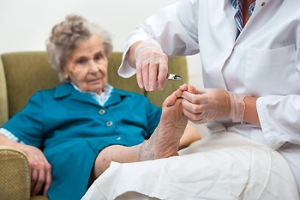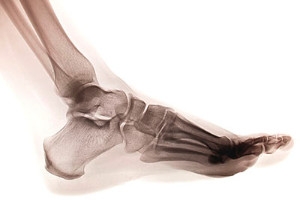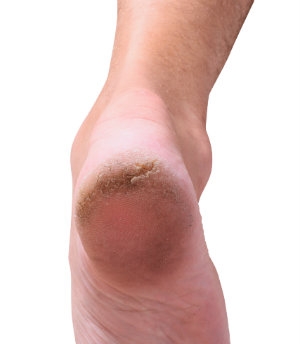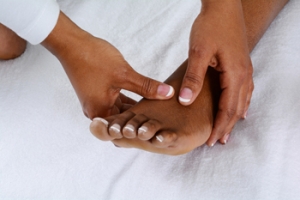
Contagious Athlete’s Foot
 The obvious symptoms that are associated with athlete’s foot is mild to severe itching, especially between the toes. This uncomfortable condition is caused by a fungus that is known as trichophyton, and thrives in warm and moist areas, which may include the inside of shoes or socks. Additionally, this contagious fungus may live in public pools, locker rooms and surrounding areas, and it is suggested to wear appropriate shoes if you are in these places. Patients who have severe cases of athlete's’ foot may experience red, flaky, and cracked skin on the side and soles of the feet, and in extreme cases, blisters and swelling may develop. If you have become afflicted with these symptoms, it is suggested to seek the counsel of a podiatrist who can perform a correct diagnosis and proper treatment options can be discussed.
The obvious symptoms that are associated with athlete’s foot is mild to severe itching, especially between the toes. This uncomfortable condition is caused by a fungus that is known as trichophyton, and thrives in warm and moist areas, which may include the inside of shoes or socks. Additionally, this contagious fungus may live in public pools, locker rooms and surrounding areas, and it is suggested to wear appropriate shoes if you are in these places. Patients who have severe cases of athlete's’ foot may experience red, flaky, and cracked skin on the side and soles of the feet, and in extreme cases, blisters and swelling may develop. If you have become afflicted with these symptoms, it is suggested to seek the counsel of a podiatrist who can perform a correct diagnosis and proper treatment options can be discussed.
Athlete’s foot is an inconvenient condition that can be easily reduced with the proper treatment. If you have any concerns about your feet and ankles, contact one of our podiatrists from Pennsylvania. Our doctors will treat your foot and ankle needs.
Athlete’s Foot: The Sole Story
Athlete's foot, also known as tinea pedis, can be an extremely contagious foot infection. It is commonly contracted in public changing areas and bathrooms, dormitory style living quarters, around locker rooms and public swimming pools, or anywhere your feet often come into contact with other people.
Solutions to Combat Athlete’s Foot
- Hydrate your feet by using lotion
- Exfoliate
- Buff off nails
- Use of anti-fungal products
- Examine your feet and visit your doctor if any suspicious blisters or cuts develop
Athlete’s foot can cause many irritating symptoms such as dry and flaking skin, itching, and redness. Some more severe symptoms can include bleeding and cracked skin, intense itching and burning, and even pain when walking. In the worst cases, Athlete’s foot can cause blistering as well. Speak to your podiatrist for a better understanding of the different causes of Athlete’s foot, as well as help in determining which treatment options are best for you.
If you have any questions please feel free to contact one of our offices located in Plymouth Meeting and Ambler, PA . We offer the newest diagnostic and treatment technologies for all your foot and ankle needs.
Athlete’s Foot
Athlete’s foot, or tinea pedis, is a skin disease caused by a fungal infection. The infection typically occurs between the toes, and the feet are most subject to this disease because shoes best create the warm, dark, and moist environment in which fungus thrives. Other areas that create a similar environment, such as swimming pools, public showers, and locker rooms; can also promote fungi growth.
Symptoms of athlete’s foot include dry skin, itching, scaling, inflammation, and blistering. Sometimes, blisters can evolve into the cracks or breaks in the skin. The exposed tissue can then create pain, swelling, and discharge. The spread of infection can cause itching and burning as well.
While athlete’s foot commonly occurs between the toes, it may also spread to the toenails or soles of the feet. Other parts of the body, such as the groin or underarms, can also become infected if they are touched after the original area of infection is scratched. Aside from physical contact, athlete’s foot can also spread through the contamination of footwear, clothing or bedsheets.
Proper foot hygiene is essential in preventing athlete’s foot. You can prevent the fungus from spreading by frequently washing your feet using soap and water, thoroughly drying the feet between the toes, changing shoes and socks every day to reduce moisture, and ensuring that bathroom and shower floors are disinfected. Other tips include using shower shoes, avoiding walking barefoot in public environments, wearing light and airy shoes, and wearing socks that keep the feet dry.
While treatment for athlete’s foot can involve topical or oral antifungal drugs, mild cases of the infection can be treated by dusting foot powder in shoes and socks. Any treatment used can be supplemented by frequently bathing the feet and drying the toes. If proper foot hygiene and self-care do not ease your case of athlete’s foot, contact your podiatrist. He will determine if the underlying cause of your condition is truly a fungus. If that is the case, a comprehensive treatment plan may be suggested with the inclusion of prescription antifungal medications.
The Importance of Checking Your Feet Daily
 Foot health is always important, but its importance increases with age. Foot care becomes increasingly crucial for older adults. Performing daily foot exams is essential in making sure your feet are healthy, especially if you have diabetes. These daily exams can be easily accomplished when moisturizing your feet, which also helps overall foot health. Moisturizing daily assists in preventing cracking of the skin, but while moisturizing it is imperative to check the whole foot for wounds, sores, blisters, calluses, and corns. If you find any sores or wounds, then wash them and apply antibiotic ointment. Apply bandages to any callus or corns to prevent further friction. Sadly for older adults, small conditions like these can lead to larger complications, so paying attention to your feet is important. If you have any concerns involving your foot health, then it is strongly recommended that you speak with a podiatrist to learn more about any particular issue.
Foot health is always important, but its importance increases with age. Foot care becomes increasingly crucial for older adults. Performing daily foot exams is essential in making sure your feet are healthy, especially if you have diabetes. These daily exams can be easily accomplished when moisturizing your feet, which also helps overall foot health. Moisturizing daily assists in preventing cracking of the skin, but while moisturizing it is imperative to check the whole foot for wounds, sores, blisters, calluses, and corns. If you find any sores or wounds, then wash them and apply antibiotic ointment. Apply bandages to any callus or corns to prevent further friction. Sadly for older adults, small conditions like these can lead to larger complications, so paying attention to your feet is important. If you have any concerns involving your foot health, then it is strongly recommended that you speak with a podiatrist to learn more about any particular issue.
If you need your feet checked, contact one of our podiatrists of Pennsylvania. Our doctors will attend to all of your foot and ankle needs and provide you with quality treatment.
Geriatrics and Podiatry
When people age, some common issues that may occur are bone density loss, dry skin, poor circulation, and rough brittle nails. These issues may also affect your foot health if the necessary steps are not taken to alleviate the problems.
It is important to take care of your feet because feet that are injured or diseased can affect your overall health. Having painful feet hinders your ability to do daily activities or may decrease your willingness to do the things that you need to do.
Visiting Your Geriatrician
As we age, health problems become more likely, so it is essential to visit your doctor for check-ups to ensure that you are doing the best you can to take care of your health. It is recommended to check your feet frequently for any possible cuts, bruises, swelling, corns or any other irregularities.
Taking Care of Elderly Feet
Cracked or dry feet can be treated by applying moisturizer often. It is also important not to wear old socks because the older the sock is, the higher the possibility there will be that there is bacteria there. Wear fresh socks and make sure they fit properly.
Proper foot health means that you can have a more active lifestyle and you will not be bogged down by pain. Foot health also leads to good circulation, which is paramount for overall health.
If you have any questions, please feel free to contact one of our offices located in Plymouth Meeting and Ambler, PA . We offer the newest diagnostic tools and technology to treat your foot and ankle needs.
Geriatrics and Podiatry
Bone density loss, dry skin, poor circulation, and rough and brittle nails are some of the common problems that can occur as people age. The effect that these problems has on foot health should be of particular concern in comprehensive geriatric care.
Feet that are diseased or injured have a negative effect on overall health and safety. Painful feet limit a person’s willingness and ability to stay active. Poor foot health can also cause gait change, which can lead to falls and accidents. Even though recovery time from health problems naturally slows as we age, many foot problems can be avoided altogether with regular prophylactic care.
Feet should be thoroughly washed in warm water daily. Care must be taken to dry the feet well, making sure to dry between and under the toes. Any left-over moisture can cause problems like foot fungus. After cleaning feet carefully check for problems such as cracked skin, bruises, swelling, cuts, corns, or other irregularities.
Examine toenails for ingrown, jagged, or split nails. Long toenails should be cut straight across. Never cut toenails at an angle or down the side as this may lead to ingrown nails.
Cracked and dry feet should be treated once or twice a day with a non-greasy moisturizer. Rub the moisturizer into the skin and allow it to dry before putting on socks and shoes. Sweaty feet can be dusted with a small amount of talcum powder. Avoid putting talcum directly into shoes as this may make feet slip within the shoe and cause a serious fall.
Wear clean dry socks each day. Not only do clean socks feel better on the feet, but socks worn for longer periods may harbor disease and odor-causing bacteria. Socks should not be tight around the top as they can leave marks on the leg. Socks that are too small can bring about bruising caused by pressure against the toes.
Wear comfortable and well-fitting shoes. If possible, consult a professional footwear specialist when purchasing shoes. Do not walk around barefoot as this exposes the feet to possible injury and bacteria.
Good foot health allows a more active lifestyle, which improves blood flow. Good circulation aids in recovery from injury or illness. It is also important for maintaining overall health.
Serious health problems can manifest themselves as symptoms in the feet. The elderly should seek professional help from a podiatrist if experiencing foot problems like tingling, numbness, pain, infection, or a sore that does not heal. Taking care of these problems right away can prevent the development of severe cases.
How to Care for Your Broken Foot
 A broken foot is one of the most debilitating injuries one can face, due to the fact that it hinders your ability to walk. A speedy recovery is ideal when dealing with broken bones, especially when it comes to broken bones within the feet. The recovery period is usually 6-8 weeks, but taking care of yourself and your feet is key in making sure you recover in a timely manner. To begin, try to take your pain medications exactly as instructed by your physician. Try leaving your splint on until your scheduled follow-up appointment and avoid putting weight on the injured foot. Try to ice your foot for 10-20 minutes every 1-2 hours the first few days following the initial injury, or until the swelling goes down. Doing this in conjunction with keeping your foot elevated above your heart, may help subside the swelling. Follow all the cast and foot care instructions your doctor gave you to avoid delaying the healing process. If you would like any additional information on how to care for a broken foot properly, then it is suggested you speak with a podiatrist.
A broken foot is one of the most debilitating injuries one can face, due to the fact that it hinders your ability to walk. A speedy recovery is ideal when dealing with broken bones, especially when it comes to broken bones within the feet. The recovery period is usually 6-8 weeks, but taking care of yourself and your feet is key in making sure you recover in a timely manner. To begin, try to take your pain medications exactly as instructed by your physician. Try leaving your splint on until your scheduled follow-up appointment and avoid putting weight on the injured foot. Try to ice your foot for 10-20 minutes every 1-2 hours the first few days following the initial injury, or until the swelling goes down. Doing this in conjunction with keeping your foot elevated above your heart, may help subside the swelling. Follow all the cast and foot care instructions your doctor gave you to avoid delaying the healing process. If you would like any additional information on how to care for a broken foot properly, then it is suggested you speak with a podiatrist.
A broken foot requires immediate medical attention and treatment. If you need your feet checked, contact one of our podiatrists from Pennsylvania. Our doctors can provide the care you need to keep you pain-free and on your feet.
Broken Foot Causes, Symptoms, and Treatment
A broken foot is caused by one of the bones in the foot typically breaking when bended, crushed, or stretched beyond its natural capabilities. Usually the location of the fracture indicates how the break occurred, whether it was through an object, fall, or any other type of injury.
Common Symptoms of Broken Feet:
- Bruising
- Pain
- Redness
- Swelling
- Blue in color
- Numbness
- Cold
- Misshapen
- Cuts
- Deformities
Those that suspect they have a broken foot shoot seek urgent medical attention where a medical professional could diagnose the severity.
Treatment for broken bones varies depending on the cause, severity and location. Some will require the use of splints, casts or crutches while others could even involve surgery to repair the broken bones. Personal care includes the use of ice and keeping the foot stabilized and elevated.
If you have any questions please feel free to contact one of our offices located in Plymouth Meeting and Ambler, PA . We offer the newest diagnostic and treatment technologies for all your foot and ankle needs.
Causes, Symptoms, and Treatment for a Broken Foot
The human foot has 26 different bones, and the foot is divided into three parts: the hindfoot, the midfoot, and the forefoot. Each section of the foot is composed of a different amount of bones. For instance, the forefoot is made up of 19 bones. The midfoot is composed of five smaller bones called the navicular, cuboid, and three cuneiform bones. Lastly, the hindfoot is made up of only the talus and the calcaneus. The feet tend to be vulnerable to slipping and twisting; consequently, fractured bones within the foot are common. When a bone gets crushed, bent, twisted, or stretched it may become broken.
Many foot fractures occur through an accident or trauma. More specifically, common causes for broken feet are car accidents, falls, missteps, or overuse. If you have a broken ankle or foot, you may have one or more of the following symptoms: throbbing pain, swelling, bruising, tenderness, deformities, and difficulty walking.
There are some factors that may put you at a higher risk of developing a broken foot. People who participate in high-impact sports are more likely to develop foot fractures because of the stresses, direct blows, and twisting injuries involved in gameplay. Additionally, those who suddenly increase their activity level are more likely to suffer a stress fracture.
Unfortunately, there are different complications that may arise because of a foot fracture. For instance, arthritis may be caused by fractures that extend into the joints. Bone infections are also possible in open fractures due to the bone being exposed to bacteria. However, there are ways you can help prevent yourself from breaking your foot. One way to avoid fractures is to wear proper footwear. If you plan on going on a run, you should wear running shoes. You should also replace your shoes if you notice that they are becoming worn out. For runners, it is best to replace shoes every 300 to 400 miles.
Treatment for foot fractures usually consists of rest, ice, elevation, and compression (RICE). If you plan on wrapping your foot, try not to wrap it too tightly because doing so may cut off blood supply in the foot. You should also avoid walking on the fractured foot.
If you suspect you have a broken foot, you should see your podiatrist right away. It is important that you have someone bring you to your doctor, since driving with a broken foot can be dangerous. You should especially seek urgent care if you are experiencing numbness, pain, or deformities in your foot.
Moisturizing May Help Cracked Heels
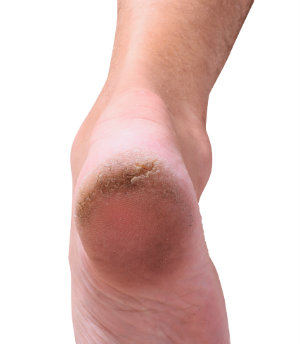 The medical term that is referred to as cracked heels may develop more frequently during the warmer months, and this may be a result of wearing shoes that have an open back. Many of these types of sandals do not provide adequate support for the heel, and fissures, or cracks in the skin, may form. Pain and discomfort may be experienced if this condition is left untreated, and infections may develop as a result of this. There may be additional reasons why cracked heels may form, and these may include medical conditions such as eczema and psoriasis, or possibly an inherited gene. There may be changes that can be implemented to prevent this ailment from developing, which may include wearing shoes that have closed backs, so the heel is not exposed and washing and drying the feet thoroughly followed by utilizing a good moisturizer. This may be effective in soothing dry skin. If you are afflicted with cracked heels, it is advised to seek the counsel of a podiatrist who can offer proper treatment options.
The medical term that is referred to as cracked heels may develop more frequently during the warmer months, and this may be a result of wearing shoes that have an open back. Many of these types of sandals do not provide adequate support for the heel, and fissures, or cracks in the skin, may form. Pain and discomfort may be experienced if this condition is left untreated, and infections may develop as a result of this. There may be additional reasons why cracked heels may form, and these may include medical conditions such as eczema and psoriasis, or possibly an inherited gene. There may be changes that can be implemented to prevent this ailment from developing, which may include wearing shoes that have closed backs, so the heel is not exposed and washing and drying the feet thoroughly followed by utilizing a good moisturizer. This may be effective in soothing dry skin. If you are afflicted with cracked heels, it is advised to seek the counsel of a podiatrist who can offer proper treatment options.
If the skin on your feet starts to crack, you may want to see a podiatrist to find treatment. If you have any concerns, contact one of our podiatrists from Pennsylvania. Our doctors can provide the care you need to keep you pain-free and on your feet.
Cracked Heels
It is important to moisturize your cracked heels in order to prevent pain, bleeding, and infection. The reason cracked heels form is because the skin on the foot is too dry to support the immense pressure placed on them. When the foot expands, the dry skin on the foot begins to split.
Ways to Help Heal Them
- Invest in a good foot cream
- Try Using Petroleum Jelly
- Ease up on Soaps
- Drink Plenty of Water
Ways to Prevent Cracked Heels
- Moisturize After Showering
- Skip a Shower
- Keep Shower Water Lukewarm
- Don’t Scrub Your Feet
If you are unsure how to proceed in treating cracked heels, seek guidance from a podiatrist. Your doctor will help you with any questions or information you may need.
If you have any questions, please feel free to contact one of our offices located in Plymouth Meeting and Ambler, PA . We offer the newest diagnostic and treatment technologies for all your foot care needs.
Solutions for Cracked Heels
Cracked heels may make you want to think twice about showing off your feet in warmer weather. However, cracked heels may be harmful to more than just the appearance of your feet. If deep fissures and cracks develop in your heels, they may make walking and standing painful for you. Additionally, these openings make way for germs to enter through your skin and cause infection.
There are several different causes of cracked heels. One of the most common reasons for this ailment is dry skin. This problem may make your keeps feel rough tight and itchy. Dry skin may be caused by cold air, extremely hot water, harsh soaps, and aging. Skin disorders such as eczema and psoriasis may eventually lead to dry skin. In some cases, complications may arise from cracked heels. Some of these complications are a loss of feeling in the heel, cellulitis, or a diabetic foot ulcer.
There are ways you can try to prevent getting cracked heels. One of the best ways to do so is to avoid wearing flip flops and sandals because these shoes increase your risk of drying out your feet. You should also avoid wearing shoes with a tall skinny heel, because these shoes cause your heel to expand sideways. At night, you should slather on a thick moisturizing cream on your feet and then cover them in socks to keep your feet moisturized overnight. Drinking water to stay hydrated is also a good way to ensure that your skin doesn’t become dry.
If you suffer from a severe case of cracked feet, you should make an appointment with your podiatrist to see what treatment methods are best for you.
Pain in the Top of the Foot
 The foot is comprised of many different parts, including bones, muscles, ligaments and tendons. Overuse and continual stress on the feet can cause various foot complications. Some conditions cause pain on the top of the foot, which can be mild or severe. Some common conditions that cause pain on the top of the foot are extensor tendonitis, stress fractures, and bone spurs. Extensor tendonitis usually results from overuse or ill-fitting shoes and causes tendons that run along the top of the foot to become inflamed. Stress fractures are fractures in the metatarsal bones, which usually lead to swelling and pain. Bone spurs are painful growths that form along joints and can sometimes make it hard to walk. All of these conditions can be treated without much difficulty. If you are suffering from pain in your foot, then it is highly suggested that you speak with a podiatrist to learn about treatment options.
The foot is comprised of many different parts, including bones, muscles, ligaments and tendons. Overuse and continual stress on the feet can cause various foot complications. Some conditions cause pain on the top of the foot, which can be mild or severe. Some common conditions that cause pain on the top of the foot are extensor tendonitis, stress fractures, and bone spurs. Extensor tendonitis usually results from overuse or ill-fitting shoes and causes tendons that run along the top of the foot to become inflamed. Stress fractures are fractures in the metatarsal bones, which usually lead to swelling and pain. Bone spurs are painful growths that form along joints and can sometimes make it hard to walk. All of these conditions can be treated without much difficulty. If you are suffering from pain in your foot, then it is highly suggested that you speak with a podiatrist to learn about treatment options.
Foot Pain
Foot pain can be extremely painful and debilitating. If you have a foot pain, consult with one of our podiatrists from Pennsylvania. Our doctors will assess your condition and provide you with quality foot and ankle treatment.
Causes
Foot pain is a very broad condition that could be caused by one or more ailments. The most common include:
- Bunions
- Hammertoes
- Plantar Fasciitis
- Bone Spurs
- Corns
- Tarsal Tunnel Syndrome
- Ingrown Toenails
- Arthritis (such as Gout, Rheumatoid, and Osteoarthritis)
- Flat Feet
- Injury (from stress fractures, broken toe, foot, ankle, Achilles tendon ruptures, and sprains)
- And more
Diagnosis
To figure out the cause of foot pain, podiatrists utilize several different methods. This can range from simple visual inspections and sensation tests to X-rays and MRI scans. Prior medical history, family medical history, and any recent physical traumatic events will all be taken into consideration for a proper diagnosis.
Treatment
Treatment depends upon the cause of the foot pain. Whether it is resting, staying off the foot, or having surgery; podiatrists have a number of treatment options available for foot pain.
If you have any questions, please feel free to contact one of our offices located in Plymouth Meeting and Ambler, PA . We offer the newest diagnostic and treatment technologies for all your foot care needs.
Foot Pain
The feet, being the foundation of the body, carry all of the body’s weight and are therefore prone to experiencing pain and discomfort. If you are experiencing foot pain, it is important to determine where in the foot you are experiencing this pain to help discover the cause of it. While pain can be experienced virtually anywhere in the foot, the most common sites of foot pain are in the heel and ankle.
Heel pain can be due to a multitude of conditions including plantar fasciitis, Achilles tendinitis, and heel spurs. Pain experienced in the ankle can be a sign of an ankle sprain, arthritis, gout, ankle instability, ankle fracture, or nerve compression. In more serious cases, pain in the foot can be a sign of improper alignment or an infection.
Foot pain can be accompanied by symptoms including redness, swelling, stiffness and warmth in the affected area. Whether the pain can be described as sharp or dull depends on the foot condition behind it. It is important to visit your local podiatrist if your foot pain and its accompanying symptoms persist and do not improve over time.
Depending on the location and condition of your foot pain, your podiatrist may prescribe certain treatments. These treatments can include but are not limited to prescription or over-the-counter drugs and medications, certain therapies, cortisone injections, or surgery.
If you are experiencing persistent foot pain, it is important to consult with your foot and ankle doctor to determine the cause and location. He or she will then prescribe the best treatment for you. While milder cases of foot pain may respond well to rest and at-home treatments, more serious cases may take some time to fully recover.

